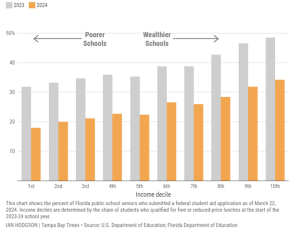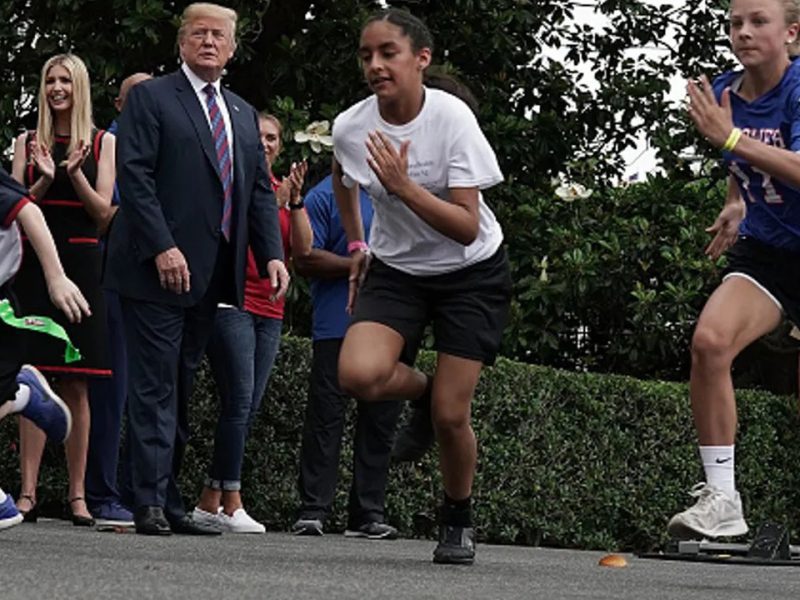
Florida student aid requests plunge. How many will delay or skip college?
Applications for federal college grants and loans are down 33% in the state, and down over 40% at the poorest schools.
Tampa Bay Times | Ian Hodgson | April 9, 2024
Students and families were promised last year that the federal application for college financial aid was about to get easier. The number of questions they had to answer dropped from 100 to 36.
But after a three-month delay in making the form available and a series of crippling mistakes, completions are way down, according to federal data. While families are being encouraged to submit the Free Application for Federal Student Aid, known as the FAFSA, some are unable to finish it or may have been deterred from the process.
The barriers threaten to delay entry into college for many students, and data shows a number of them will never make another attempt. Low-income students are impacted the most.
As of March 22, less than one-quarter of Florida public high school seniors had submitted their application — down one-third from the same time last year, according to a Tampa Bay Times analysis of federal data.
In Hillsborough and Pasco counties, about one-quarter of high school seniors in public schools had submitted an aid application. It was about a third in Pinellas. All three districts were down over 30% from the same time last year, an overall drop of nearly 3,000 students.
The numbers are even worse for low-income Floridians: Roughly 2 out of 10 students at the state’s 50 poorest high schools have completed the application this year, down over 40% from this time last year.
Despite those declines, advocates say they’ve seen little urgency from school districts or state officials to take action.
With fewer of them applying, Florida graduates appear likely to surpass the $353 million of federal aid they left on the table in 2023, according to the National College Access Network, a nonprofit that advocates for equity in higher education.
Since a “soft launch” of the new form on Dec. 31, the U.S. Department of Education has been inundated with complaints from students locked out of their accounts, waiting endlessly on the department’s help line, or left unable to correct simple mistakes.
On March 22, the department announced another problem — a calculation error in the form that would further delay the process.
Lower-income students are furthest behind
Federal Pell grants, which offer up to $7,395 in funding, depend on the aid form — as do federally subsidized student loans and many school-based aid packages. Most of those funds are directed toward lower-income families, but a two-parent family of four in Florida could expect some Pell money if household income is under $76,313, according to federal guidance.
Lower-income students are the most likely to depend on financial assistance to determine where they attend college, or if they go at all, said Braulio Colón, head of the Florida College Access Network, a nonprofit that tracks completion rates.
“There is no bigger barrier than the ability to pay,” he said. “Nothing is more important for these families than filling out this form.”
Federal student aid applications were lowest among Florida’s poorest schools
The share of seniors who submitted a federal aid application fell by over 40% at schools with the highest share of students qualifying for free or reduced-price lunches. Schools are divided into 10 equal-sized groups by income, from the poorest 50 schools to the wealthiest.
The worst-case scenario is if a student has to wait to go to college or has to withdraw for a year because they can’t pay, Colón said. “There’s a significant percentage who will simply not come back.”
The worst-case scenario is if a student has to wait to go to college or has to withdraw for a year because they can’t pay, Colón said. “There’s a significant percentage who will simply not come back.”
High schools with more low-income students typically fill out the federal aid form at lower rates than more affluent schools. But the difference is even more stark this year, according to the Times analysis, which measured income using the share of students receiving free or reduced-price lunch.
Statewide, submissions of the form at the 50 wealthiest schools were nearly double those at the bottom 50, where application data for this year was available.
The downturn may compound the already-declining representation of lower-income students at the state’s most selective universities. A 2022 Times analysis found that as the University of Florida, Florida State University and the University of South Florida climbed the U.S. News & World Report rankings, the share of lower-income students with Pell grants dropped dramatically at those schools.
Erasing recent gains
Since 2019, the Pinellas County school district has gradually added college and career centers to each of its 17 public high schools.
The initiative sparked a turnaround in federal student aid applications.
A Times analysis found that aid applications increased more than 5% each time a Pinellas high school opened a center prior to the changes.
Two years ago, nearly 3 in 5 of Pinellas’ 7,000 public high school seniors completed the federal aid application — the 10th-highest rate in the state. But for this year at least, problems with the new federal form have wiped out the half-decade of gains.
As of March 22, roughly one-third of Pinellas high school seniors submitted an application.
“I don’t know if school districts are pushing this really hard,” said University of South Florida vice president of enrollment Billie Joe Hamilton, noting the apparent lack of urgency from state and local education officials to boost applications.
There’s only so much universities can do, Hamilton said. They’ve sent email reminders to current and admitted students and participated in district-organized events in Pinellas, she said.
USF, along with the University of Florida and the University of Central Florida, recently announced that prospective students would have an extra two weeks — until May 15 — to lock in their enrollment decisions.
Representatives from Pinellas and Hillsborough school districts said district officials were aware of the decline in applications and were taking steps to encourage submissions.
Part of the drop may be due to a flaw that prevented parents without a Social Security number from completing the form. But in Florida, that problem doesn’t impact enough families to account for the massive decline in submissions, said Hamilton.
Students facing that difficulty would not be held to USF’s May 15 deadline, she added.
Still, Hamilton said she remained hopeful that applications will return to normal soon. The new form pulls family income data directly from the IRS, rather than requiring parents to painstakingly enter the information themselves, as in previous years.
“In the long run, this is going to be so much better for families,” Hamilton said. “This year it’s just been really hard.”
Ian Hodgson is an education data reporter for the Tampa Bay Times, working in partnership with Open Campus.





